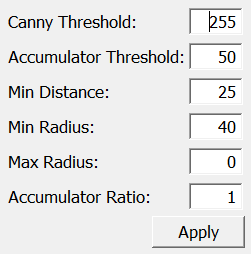cvHoughCircles¶
- MLModule¶
author
package
dll
definition
Purpose¶
The cvHoughCircles performs the OpenCV 2D “Hough circles” algorithm.
It detects circles on each 2D slice of the given volume and generates markers with the centers and radii of the detected circles. The radius is stored in the direction component of the vector, orthogonal to the 2D slice. The markers are stored in world coordinates. A good way to visualize the markers is to use a SoView2DMarkerEditor with drawMode set to Disc, as shown in the example module.
Internally, the module only supports the uint8 data type; all input data is rescaled to the range 0-255.
Windows¶
Default Panel¶

Input Fields¶
input0¶
- name: input0, type: Image¶
Output Fields¶
outCircles¶
- name: outCircles, type: XMarkerList(MLBase)¶
For accessing this object via scripting, see the Scripting Reference:
MLXMarkerListWrapper.
Parameter Fields¶
Field Index¶
|
|
|
|
|
|
|
Visible Fields¶
Min Distance¶
- name: minDistance, type: Double, default: 10¶
Sets the minimum distance between detected circle centers.
Min Radius¶
- name: minRadius, type: Integer, default: 0¶
Sets the minimum radius of detected circles.
Max Radius¶
- name: maxRadius, type: Integer, default: 0¶
Sets the maximum radius of detected circles.
A value of 0 means the maximum radius is not limited.
Canny Threshold¶
- name: cannyThreshold, type: Double, default: 100¶
Sets the threshold for the canny edge detection (in rescaled 8-bit range).
Accumulator Ratio¶
- name: accumulatorRatio, type: Double, default: 1¶
Sets the resolution of the accumulator.
A value of 0.5 means the accumulator has half the resolution of the image.
Accumulator Threshold¶
- name: accumulatorThreshold, type: Double, default: 100¶
Sets the accumulator threshold for detecting a circle.
The smaller the value, the more false circles may be detected. Circles corresponding to larger accumulator values will be returned first.
Apply¶
- name: apply, type: Trigger¶
When pressed, circle detection is applied.